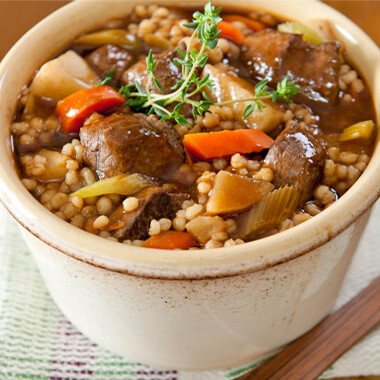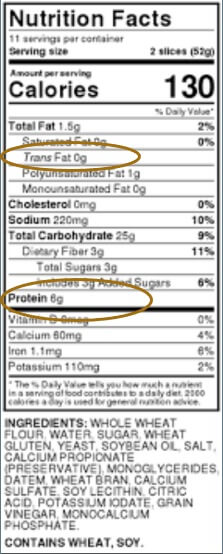Healthy Living - including ancient grains in your diet
FEATURED RECIPE
Beef & Barley Soup

Recipe & Picture from Go Barley
Ingredients
- 1 ½ lbs. boneless beef chuck or blade
- 1 tbsp oil
- 1 medium onion, diced
- 1 clove garlic, minced
- 2 tbsp tomato paste
- ½ cup pearl or pot barley
- 2 (10 ounce) cans low salt beef broth
- 1 cup water
- 1 tbsp Worcestershire sauce
- ½ tsp dried thyme
- 1 bay leaf
- 1 medium turnip, diced
- 3 carrots, sliced
- 2 stalks celery, sliced
- Salt and pepper to taste
Instructions
- Cut beef into 1 ½ inch cubes.
- In a large pot, heat oil over medium-high heat; add beef and brown well on all sides.
- Remove browned beef to a bowl.
- Add onion to the pot and cook for 3 minutes.
- Stir in garlic and tomato paste; cook for 2 minutes.
- Add browned beef, barley, undiluted beef broth, water, and Worcestershire sauce; bring to a boil and reduce heat.
- Add thyme, bay leaf and remaining vegetables; simmer for 1 to 1 ½ hours or until meat, barley and vegetables are tender.
- Season to taste with salt and pepper.
One Small Thing – Recognize Whole Grains
When shopping for whole grains, make sure that the product truly is a whole grain. The first ingredient should be whole grain flour, and each serving should provide at least 3 grams of fiber.

Ancient & Modern Grains – The Whole Truth
Humans started storing and eating grains regularly around 20,000 years ago. Most commonly consumed grains, such as wheat and rice, have been bred and changed over time. Today, grains are considered an essential part of a balanced diet providing energy to our bodies and brains.
“Ancient grains” is a label applied to types of whole grains that have been largely unchanged for thousands of years. Several popular varieties are listed in the table below, along with their nutrition profile and suggested uses.
Ancient grains are commonly consumed in their whole form, whereas modern grains are available in a large variety of whole and refined grains. The health superiority of whole grains over refined grains is well established. Refined grains contain only the starchy endosperm and lose about two-thirds of their nutrients, including fiber, B vitamins, iron, folate, selenium, potassium, magnesium, and other disease-fighting nutrients.
Although food manufacturers are required to enrich their refined food products, this only returns 5 nutrients (vitamins B1, B2, B3, B9, and iron). Epidemiological studies have found that high consumption of refined grains may increase markers of inflammation in the body, such as C-reactive protein. Low-grade inflammation has been linked with heart disease and type 2 diabetes, among other health problems.
Whole grains contain the outer bran layer, rich in fiber and B vitamins, and the germ which is full of antioxidants. Whole grains are great sources of longer, sustained energy that can keep you going throughout the day. Studies have shown that eating whole grains can reduce the risk of stroke, type II diabetes, asthma, inflammatory diseases, colorectal cancer, and heart disease, as well as it helps to maintain a healthy weight and blood pressure.
According to Harvard University, compared to people who didn’t eat many whole grains each day, people who ate four servings of whole grains daily (about 70 grams) during the study period had a 22% lower risk of death from any cause, a 23% lower risk of dying from cardiovascular disease, and a 20% lower risk of dying from cancer.
Ancient grains are good for our health mostly because they are eaten whole, and they retain most of their nutrients. Each one has a unique nutrient profile and taste. Including these ancient grains can be a great way to add whole grains to your diet.
Bottom Line: Whether ancient or modern, choose whole grains most of the time.
Here are some ways to include whole grains in your meals, including ancient grains.
- Make risottos, pilafs, and other rice-like dishes with whole grains such as barley, brown rice, bulgur, millet, quinoa, or sorghum.
- Substitute half of your traditional pancake mix for pancake mix made of buckwheat, millet or teff.
- Use barley instead of rice or noodles in your soups.
- Add half a cup of cooked bulgur, wild rice, or barley to bread stuffing.
- Use quinoa or farro instead of bulgur when preparing tabbouleh.
Additional tips: Cook your ancient grains in advance, spread them on a cookie sheet to cool, and freeze them in containers or plastic bags. You can then add them to your dishes anytime.
Popular Ancient Grains
| Name | Origin | Nutrition Qualities | Culinary Uses |
|---|---|---|---|
| Amaranth* | Peru, Mexico | Protein, iron, calcium, Vit C, phosphorus, manganese, selenium, magnesium,lysine (essential acid missing in many grains) | Nutty flavor & fine texture – used for baking, and for thickening soups, stews, and sauces. |
| Barley | Fertile Crescent | Molybdenum, manganese, and selenium Fiber – esp. Beta Glucans, known for cholesterol reduction. | Soups, pilafs, flour for bread-baking |
| Buckwheat* | Asia, Eastern Europe | Magnesium, fiber, protein. rutin & quercetin – potent antioxidants | Soba noodles, cereals, pancake mixes, baked goods |
| Bulgar | Middle East, Mediterranean | Manganese, magnesium, and iron.Fiber | Tabbouleh, salads, pilaf, stuffing for vegetables |
| Farro | Central Mediterranean | Fiber, iron, protein, magnesium | Salads, soups, stews, risotto, hot cereal, casseroles |
| Millet* | China | Fiber, magnesium, and protein. | Bread, pancakes, baked goods, beer, cereal. |
| Quinoa* | Peru, Bolivia | Manganese, copper, zinc, iron, phosphorus, fiber, and protein.All 9 essential amino acids. | Substitute for rice in most recipes. Add to soups, stews, and “bowls.” |
| Sorghum* | Africa | Fiber, B vitamins, magnesium, potassium, phosphorus, iron, and zinc | Add to soups, stews, salads, and baked goods. |
| Teff* | Ethiopia | Copper, magnesium, potassium, phosphorus, manganese, zinc, and selenium.Lysine – amino acid missing in many other grains | Bread, pancakes, cookies, muffins, and flat breads. |
*Indicates gluten free


Comments